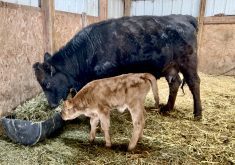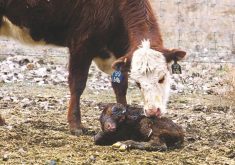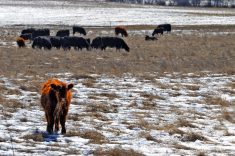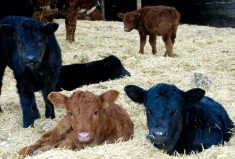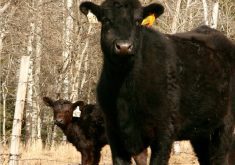Feeding a straw-grain ration to pregnant cows is a viable option, but you’ve got to do the math.
The first step is to test the quality of the feed, but determining what type of supplements or mineral product must also be done, said provincial beef and forage specialist Barry Yaremcio.
“It is often a point of consternation when choosing what to use because each company ‘has the best’ product to use,” said Yaremcio.
When considering a straw-grain ration for pregnant cows, some nutritional concerns need to be addressed.
Read Also

Farming Smarter receives financial boost from Alberta government for potato research
Farming Smarter near Lethbridge got a boost to its research equipment, thanks to the Alberta government’s increase in funding for research associations.
Straw typically is high in fibre, but low in energy, protein, calcium, and magnesium.
“Straw should not be fed at levels more than 1.5 per cent of body weight,” said Yaremcio. “To be safe, and depending on the type and age of the straw, intakes could be only 1.25 per cent of body weight.
“Using a 1,400-pound animal, straw intake can be anywhere from 17 to 21 pounds per day on a dry basis. This example may be applicable for many operations this winter that are feeding pregnant cows. Along with the straw, roughly 10 pounds of barley or 11 pounds of oats need to be included to meet energy requirements.”
This straw-grain ration example has roughly 6.5 per cent protein on a dry basis, but a cow in mid-pregnancy requires seven per cent and one in late pregnancy needs nine per cent. One option to make up this difference is to add two pounds of of peas in mid-pregnancy and five pounds in late pregnancy.
“One pound of canola meal in mid-pregnancy and three pounds in late pregnancy will also work,” added Yaremcio.
Peas cost about 10.3 cents per pound and canola meal 14.2 cents per pound while a 32 per cent supplement is about 25 cents per pound. This supplement is designed to be fed at one pound per head per day but this doesn’t provide adequate protein for a late-pregnancy cow, so a combination of supplement and peas or canola meal will be required, said Yaremcio.
“For example, peas contain 24 per cent protein, which supplies 240 kilograms, or 528 pounds of protein from a tonne of peas. At a price of $235 per tonne, the cost of this protein is $1.08 per kilogram or 44 cents per pound. Canola meal contains 38 per cent protein, which supplies 380 kilograms, or 837 pounds, of protein per tonne. At a price of $315 per tonne, the cost of this protein is $0.91 per kilogram, or 37 cents per pound. Use this technique to minimize protein costs in the ration.”
Minerals and vitamins
Two factors need to be considered when calculating the amount of macro minerals, trace minerals, and vitamins supplied by a product.
“First, consider the expected intake of the mineral or supplement that is listed on the tag or label. Second, know the concentration of the nutrient being evaluated.”
The nutrient concentrations on the tag or label are listed as a percentage for the macro minerals (calcium, phosphorus, salt, magnesium and potassium). The trace minerals (copper, manganese, zinc, selenium, iodine and cobalt) are listed as milligrams per kilogram. Vitamins A, D and E are listed as international units (IU) per kilogram.
“For the macro minerals, multiply the inclusion rate of the product in grams by the concentration of the nutrient,” said Yaremcio. “For example, if the product is fed at 100 grams per day and contains 16 per cent calcium, multiply 100 grams by 0.16 to determine that the product will supply 16 grams of calcium. For the straw-grain ration mentioned above, a high-calcium product such as a 24:3 mineral, or even limestone is needed. A 1:1 and 2:1 mineral is not adequate to meet animals’ requirements.”
For the trace minerals and vitamins, multiply the inclusion rate of the product in kilograms by the concentration of the nutrient.
“For example, if the same product is fed at 100 grams and the copper has a concentration of 3,000 mg per kg, multiply by the intake in kg (100 g = 0.1 kg) by 3,000 to determine the product will supply 300 mg of copper. For vitamins, the process is the same but values will be in IU instead of mg.”
This process is time consuming to do by hand so Yaremcio recommends a ration-balancing program such as CowBytes. That program, produced by Alberta Agriculture, costs $50.




